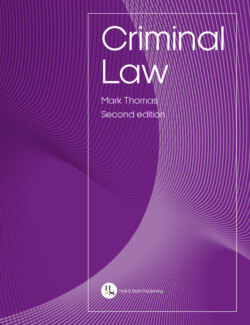Читать книгу Criminal Law - Mark Thomas - Страница 129
На сайте Литреса книга снята с продажи.
Causation
ОглавлениеLaird, ‘The Decline of Criminal Law Causation Without Limits’ (2016) 132 LQR 566.
Nkrumah, ‘R v Kennedy Revisited’ (2008) 72 J Crim L 117.
Norrie, ‘A Critique of Criminal Causation’ (1991) 54 MLR 685.
Padfield, ‘Clean water and muddy causation: is causation a question of law or fact, or just a way of allocating blame?’ [1995] Crim LR 683.
Shute, ‘Causation: Foreseeability v Natural Consequences’ (1992) 55 MLR 584.
Stannard, ‘Criminal Causation and the Careless Doctor’ (1992) 55 MLR 577.
summary
• In order to establish criminal liability, three key elements are necessary: actus reus, mens rea and the lack of a defence.
• Actus reus (or guilty act) is concerned with the external elements of the offence and covers such matters as acts, conduct, circumstances and consequences.
• Mens rea (or guilty mind) is concerned with the mental element of the offence and covers such matters as intention, recklessness, foreseeability etc.
• Defences may be justificatory in nature or may provide the defendant with an excuse for a crime. Whether it justifies or excuses the defendant’s conduct will determine whether the defence is an element of the offence or not.
• In general, the actus reus requires a voluntary and positive act.
• There are certain offences (known as state of affairs cases) where voluntary conduct is not required. In this case, the defendant is ‘being’, rather than ‘doing’ an act.
• In certain circumstances, a duty to act may impose liability on a defendant for his failure to act.
• Criminal offences can helpfully be divided into conduct and result crimes. Conduct crimes are unlawful despite the end result or consequences, whereas result crimes require the defendant’s action to cause the end result.
• Causation is divided into factual and legal causation. Both must be satisfied and require the defendant to be the cause of the end result.
• The defendant may be relieved of liability where there is a new and intervening act that breaks the chain of causation. These acts take the form of the victim’s own act, a free, deliberate and informed act of a third party, or an act of God.
• The defendant must ‘take his victim as he finds him’. This means that the defendant cannot be relieved of liability simply because the victim is more vulnerable or susceptible to harm than another person.
✓test Your Knowledge
Problem
Jack and Jill are brother and sister. Jack suffers from a low IQ and short-term memory loss and is dependent on Jill for most activities. Whilst at the top of a hill, Jill falls down a well and is trapped at the bottom. Jack, unsure of what to do, returns home with the intention of speaking to his roommate, Andy. Upon returning home, Jack forgets the reason he wished to speak to Andy and Jill is forgotten. Jill dies at the bottom of the well.
Jill’s body is later found by passers-by, a rap group called the ‘Free Blind Mice’. Upon hearing the news of his sister’s death, Jack suffers depression and lashes out at Andy. With a single punch, Jack knocks Andy unconscious and cracks his jaw. While Andy is being taken to the hospital, the ambulance is involved in an accident when the Free Blind Mice crash into it in a rush to get to their next rap concert. Andy dies in the ambulance.
Consider the liability of the individuals according to the above facts.
Would your answer differ if:
• Andy was found to have a very weak jaw line;
• Jill did not die in the well but died as a result of poor medical treatment at hospital;
• Andy jumped from the back of the ambulance as a result of fear of hospitals (Nosocomephobia). Andy cracks his skull and dies.
Essay
‘The law of causation is in a constant state of flux. The courts are unsure how to apply both factual and legal causation to a given case, and policy reasons dictate who is, and is not, liable in any given case.’
Critically discuss this statement with regard to the operation of causation in criminal law.
